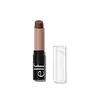What's inside
What's inside
 Key Ingredients
Key Ingredients

 Benefits
Benefits

 Concerns
Concerns

 Ingredients Side-by-side
Ingredients Side-by-side

Hydrogenated Polyisobutene
EmollientSucrose
HumectantSynthetic Wax
AbrasiveMolasses
Skin ConditioningParfum
MaskingMicrocrystalline Wax
Emulsion StabilisingTocopheryl Acetate
AntioxidantDiethylhexyl Syringylidenemalonate
Skin ProtectingPhenoxyethanol
PreservativeCaprylyl Glycol
EmollientCaprylic/Capric Triglyceride
MaskingVitis Vinifera Seed Oil
EmollientSimmondsia Chinensis Seed Oil
EmollientPersea Gratissima Oil
Skin ConditioningButyrospermum Parkii Butter
Skin ConditioningIron Oxides
Hydrogenated Polyisobutene, Sucrose, Synthetic Wax, Molasses, Parfum, Microcrystalline Wax, Tocopheryl Acetate, Diethylhexyl Syringylidenemalonate, Phenoxyethanol, Caprylyl Glycol, Caprylic/Capric Triglyceride, Vitis Vinifera Seed Oil, Simmondsia Chinensis Seed Oil, Persea Gratissima Oil, Butyrospermum Parkii Butter, Iron Oxides
Cocos Nucifera Oil
MaskingSclerocarya Birrea Seed Oil
HumectantButyrospermum Parkii Butter
Skin ConditioningCaprylic/Capric Triglyceride
MaskingBis-Diglyceryl Polyacyladipate-2
EmollientBeeswax
Emulsion StabilisingOzokerite
Emulsion StabilisingPolyisobutene
Glycine Soja Oil
EmollientCopernicia Cerifera Wax
Euphorbia Cerifera Wax
Camellia Oleifera Leaf Extract
AstringentDictyopteris Membranacea Extract
AntioxidantMagnolia Grandiflora Bark Extract
AntimicrobialCarthamus Tinctorius Seed Oil
MaskingPersea Gratissima Oil
Skin ConditioningSchinziophyton Rautanenii Kernel Oil
EmollientVaccinium Macrocarpon Seed Oil
Skin ConditioningTocopheryl Acetate
AntioxidantDipotassium Glycyrrhizate
HumectantPalmitoyl Tripeptide-1
Skin ConditioningTetrahexyldecyl Ascorbate
AntioxidantEthylhexyl Palmitate
EmollientDicaprylyl Ether
EmollientTribehenin
EmollientSorbitan Isostearate
EmulsifyingLauryl Alcohol
EmollientLinoleic Acid
CleansingLinolenic Acid
CleansingCaprylyl Glycol
EmollientPhenoxyethanol
PreservativeCocos Nucifera Oil, Sclerocarya Birrea Seed Oil, Butyrospermum Parkii Butter, Caprylic/Capric Triglyceride, Bis-Diglyceryl Polyacyladipate-2, Beeswax, Ozokerite, Polyisobutene, Glycine Soja Oil, Copernicia Cerifera Wax, Euphorbia Cerifera Wax, Camellia Oleifera Leaf Extract, Dictyopteris Membranacea Extract, Magnolia Grandiflora Bark Extract, Carthamus Tinctorius Seed Oil, Persea Gratissima Oil, Schinziophyton Rautanenii Kernel Oil, Vaccinium Macrocarpon Seed Oil, Tocopheryl Acetate, Dipotassium Glycyrrhizate, Palmitoyl Tripeptide-1, Tetrahexyldecyl Ascorbate, Ethylhexyl Palmitate, Dicaprylyl Ether, Tribehenin, Sorbitan Isostearate, Lauryl Alcohol, Linoleic Acid, Linolenic Acid, Caprylyl Glycol, Phenoxyethanol
 Reviews
Reviews

Ingredients Explained
These ingredients are found in both products.
Ingredients higher up in an ingredient list are typically present in a larger amount.
This ingredient is also known as shea butter. It is an effective skin hydrator and emollient.
Emollients help soothe and soften your skin. It does this by creating a protective film on your skin. This barrier helps trap moisture and keeps your skin hydrated. Emollients may be effective at treating dry or itchy skin.
Shea butter is rich in antioxidants. Antioxidants help fight free-radicals, or molecules that may harm the body. It is also full of fatty acids including stearic acid and linoleic acid. These acids help replenish the skin and keep skin moisturized.
While Shea Butter has an SPF rating of about 3-4, it is not a sunscreen replacement.
Shea butter may not be fungal acne safe. We recommend speaking with a professional if you have any concerns.
Learn more about Butyrospermum Parkii ButterThis ingredient is an emollient, solvent, and texture enhancer. It is considered a skin-softener by helping the skin prevent moisture loss.
It helps thicken a product's formula and makes it easier to spread by dissolving clumping compounds.
Caprylic Triglyceride is made by combining glycerin with coconut oil, forming a clear liquid.
While there is an assumption Caprylic Triglyceride can clog pores due to it being derived from coconut oil, there is no research supporting this.
Learn more about Caprylic/Capric TriglycerideCaprylyl Glycol is a humectant and emollient, meaning it attracts and preserves moisture.
It is a common ingredient in many products, especially those designed to hydrate skin. The primary benefits are retaining moisture, skin softening, and promoting a healthy skin barrier.
Though Caprylyl Glycol is an alcohol derived from fatty acids, it is not the kind that can dry out skin.
This ingredient is also used as a preservative to extend the life of products. It has slight antimicrobial properties.
Learn more about Caprylyl GlycolPersea Gratissima Oil is also known as avocado oil.
Avocado Oil has antioxidant properties. It is mostly made up of the glycerides of fatty acids. About 67% of these fatty acids is made up of oleic acid. Palmitic acid and linoleic acid are also present.
These fatty acids help hydrate and soften the skin. It may increase collagen content in the skin. Collagen helps keep your skin plump and firm. This ingredient helps reduce inflammation and has not shown to clog pores.
This ingredient may not be fungal-acne safe due to its high fatty acid content.
Avocados also have B vitamins, vitamin K, vitamin C, vitamin E, and potassium.
Learn more about Persea Gratissima OilPhenoxyethanol is a preservative that has germicide, antimicrobial, and aromatic properties. Studies show that phenoxyethanol can prevent microbial growth. By itself, it has a scent that is similar to that of a rose.
It's often used in formulations along with Caprylyl Glycol to preserve the shelf life of products.
Tocopheryl Acetate is AKA Vitamin E. It is an antioxidant and protects your skin from free radicals. Free radicals damage the skin by breaking down collagen.
One study found using Tocopheryl Acetate with Vitamin C decreased the number of sunburned cells.
Tocopheryl Acetate is commonly found in both skincare and dietary supplements.
Learn more about Tocopheryl Acetate